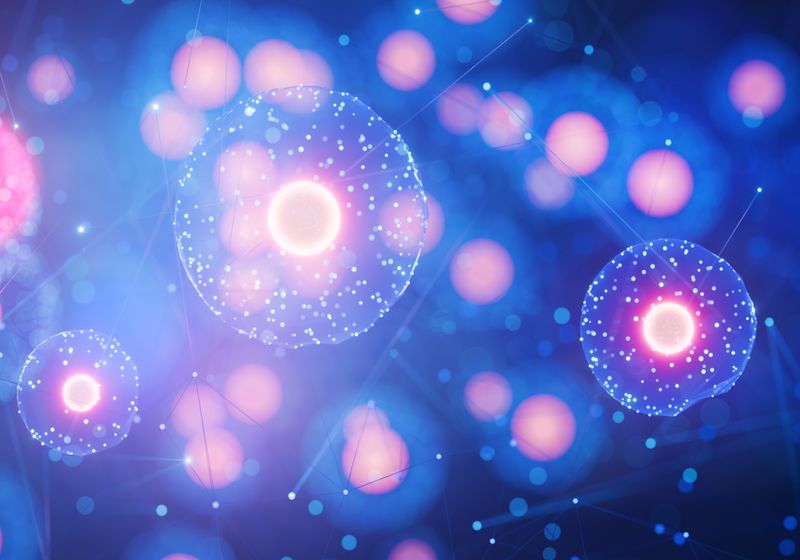Researchers used a new spatial proteomic method to map protein localization changes during viral infection.
Just like workers need the right environment to efficiently perform their tasks, proteins require placement within specific cellular compartments to function properly. Therefore, understanding where proteins reside within a cell is crucial for unraveling their roles in health and disease.
Scientists from the Chan Zuckerberg Biohub, including mass spectrometry platform leader Josh Elias, developed a new mass spectrometry-based method to map proteins’ spatial organization within cells.1 After attaching molecular tags to proteins that resided in distinct subcellular spaces, whole organelle immunoprecipitation allowed them to enrich individual compartments and assess the proteins inside with mass spectrometry. Elias’s team then determined protein changes in response to viral infection, showing that proteins involved in a type of programmed cell death called ferroptosis were relocated. Further studies of protein localization changes during infection and other disease states could highlight the biological mechanisms behind many conditions.
Why is it important to understand protein subcellular localization?
The momentum behind subcellular proteomics has been growing because cellular states are often determined by what proteins are present, who they are interacting with, and where they are in the cell. Subcellular compartments isolate potentially interacting proteins from one another so that their functions are more focused. It’s like my children—if I try to get them to clean their room, they will not if they are together. If I can separate them, then they will do their job. So, I think of proteins in that way—just because a worker is there does not mean that it is doing the work. It needs a space where that specific work can happen.
How can proteomics help scientists study protein localization?
Josh Elias is the mass spectrometry platform leader at the Chan Zuckerberg Biohub San Francisco.
Barbara Ries
Localization is tricky to study because it does not create a mark on the protein. Previously, associating proteins with compartments was done by taking fractions and separating proteins along a single spatial axis, such as with size exclusion or density gradient chromatography. Looking at the density across a gradient, proteins can be in different fractions that might correlate with where they are in the cell. Once it is known where certain proteins are, researchers can associate other proteins with those locations based on their correlation with the proteins of interest.
Our study is similar, except we are not thinking about this as a single axis. We enrich individual subcellular compartments, and that creates a complex interaction network. The goal is to establish where proteins are and how those localizations change. I think our immuno-affinity-based approach has a lot of advantages in establishing that. And with mass spectrometry, we can chart the movements of thousands of proteins in a single set of experiments.
What was the inspiration for your technique?
This work stemmed from Manuel Leonetti’s OpenCell resource, where his team fluorescent-tagged several thousand proteins and visualized them within cells.2 He saw that several proteins could be proxies for certain subcellular locations. Based on this, we created tagged cell lines that each capture one compartment. We then broke the cells apart in a non-denaturing context and used affinity chromatography across the whole cell. After mass spectrometry, we could recapitulate how different cellular sub-compartments are put together.
What effects did you see after infecting the cells with virus?
Our data showed more changes in protein localization than changes in overall abundance. For so long, proteomics researchers have focused on abundance changes, in part because one cannot measure localization changes with conventional proteomics methods. Our data suggest that localization change is important—rather than degrading and synthesizing proteins in response to challenges, cells could move a store of sequestered proteins to the place where they will be effective. That is a powerful way in which cells could rapidly and effectively respond to stimuli, such as in response to viral infection.
How do you envision applying this technique in the future?
There is a wide array of experiments that we can do with this core technology. We want to differentiate induced pluripotent stem cells into different cell types and explore how those respond to infection and other genetic perturbations, such as mutations that predispose one to neurodegenerative diseases.
This technique is not limited to proteins; we are exploring how lipidomics and metabolomics might help define compartments. Lipids are essential for defining compartments, and the lipids involved in the mitochondrion are very different from those involved in the peroxisome, for example. This may help us understand the “chicken and the egg” of why certain proteins are in a compartment versus how that compartment enables those proteins to be there. This is going to keep us busy for a while.
This interview has been condensed and edited for clarity.

